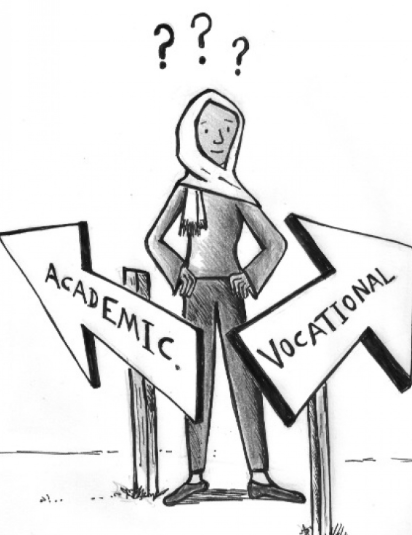Introduction
There is a lot written about Vocational and Academic training covering what they are, the differences between them, pros, cons, etc
Therefore I thought I would take a deeper look?
What is Vocational Training or Learning?
Vocational learning, also known as vocational education and training (VET), refers to instructional programs or courses that focus on the skills and knowledge required for specific trades, occupations, or careers.
Unlike traditional academic education, which is often broader and more theoretical, vocational learning is practical, hands-on, and directly linked to the needs of the labour market.
Its key features are:
- Practical Skills Development: – Vocational learning emphasizes the acquisition of specific skills and competencies needed for a particular job or trade. This includes hands-on training and practical experience.
- Industry Relevance – The curriculum is designed in collaboration with industry experts to ensure that the skills taught are up-to-date and relevant to current job market demands.
- Work-Based Learning – Programs often include apprenticeships, internships, and on-the-job training, allowing students to gain real-world experience and understand workplace dynamics.
- Certification and Credentials: – Successful completion of vocational programs typically leads to certifications, diplomas, or other credentials that are recognized and valued by employers in the relevant field.
- Flexible Pathways: – Vocational learning can be pursued at various educational levels, from secondary education to post-secondary institutions, including technical schools, community colleges, and specialized training centers.
What is academic learning?
Academic training refers to a structured and systematic approach to education that focuses on broad-based knowledge, theoretical understanding, and intellectual development across various disciplines.
It is typically delivered through formal educational institutions such as schools, colleges, and universities.
The primary goal of academic training is to equip students with critical thinking skills, analytical abilities, and comprehensive knowledge that can be applied across a wide range of fields and professions.
Its key features are:
- Theoretical Focus – Emphasis on understanding underlying principles, theories, and concepts across different subjects.
- Broad Curriculum – Offers a wide range of subjects, including humanities, sciences, social sciences, mathematics, and arts, providing a well-rounded education.
- Critical Thinking and Research – Encourages the development of critical thinking, problem-solving, and research skills, preparing students for complex intellectual tasks.
- Formal Structure – Follows a formal structure with defined courses, semesters, grading systems, and degree requirements.
- Pathway to Advanced Studies – Provides the foundational knowledge necessary for pursuing advanced degrees (e.g., master’s, doctorate) and specialized fields.
- Liberal Arts Education – Often includes a liberal arts component, promoting a well-rounded intellectual foundation and cultural awareness.
The pros and cons of Vocational Training
Its pros are:
- Job Readiness: – Graduates are prepared with practical skills tailored to specific careers, enabling them to enter the workforce quickly.
- Economic Benefits: Often leads to well-paying jobs in high-demand fields with shorter training periods compared to traditional four-year degrees.
- Flexibility: Offers flexible schedules, including part-time, evening, and online options, making it accessible to working adults and non-traditional students.
- Reduced Unemployment: Aligns education with labor market needs, helping to reduce unemployment and fill skill gaps in various industries.
- Hands-On Experience: Provides real-world experience through apprenticeships, internships, and on-the-job training.
- Cost-Effective : Typically less expensive than a traditional four-year college education, reducing student debt.
But its cons are:
- Perceived Stigma: Societal bias often favors traditional academic education, which can influence perceptions and choices.
- Limited Scope: Highly specialized training may limit graduates’ flexibility to switch career paths without additional education.
- Variable Quality: Quality of vocational programs can vary, with some institutions lacking adequate resources and training.
- Market Fluctuations: Demand for specific vocational skills can change with economic shifts, potentially affecting job stability.
- Access and Funding: Some programs may be expensive or lack sufficient funding and resources, limiting accessibility for some students.
The pros and cons of Academic Learning
Its pros are::
- Broad Knowledge Base: Provides a comprehensive education across various disciplines, fostering critical thinking and analytical skills.
- Career Flexibility: A broad education allows for greater flexibility in career choices and the ability to switch fields.
- Higher Earning Potential: Graduates often have higher earning potential over their lifetime compared to those with only vocational training.
- Prestige and Recognition: Degrees from academic institutions often carry societal prestige and recognition, which can enhance career opportunities.
- Pathway to Advanced Degrees: Academic education provides the foundation for pursuing advanced degrees and specialized fields of study.
- Personal Development: Encourages personal growth, cultural awareness, and intellectual development.
Its cons are:
- Longer Duration: Typically requires a longer time commitment, often four years or more, to complete a degree.
- Higher Costs: Can be expensive, leading to significant student debt.
- Job Market Misalignment: Not all academic programs align with immediate job market needs, which can result in underemployment or unemployment for some graduates.
- Theoretical Focus: Emphasis on theoretical knowledge may leave graduates with less practical, hands-on experience compared to vocational education.
- Intensive Competition: High competition for admission to prestigious institutions and for jobs after graduation.
Summary
Both vocational and academic learning have distinct advantages and disadvantages, and the best choice depends on individual career goals, learning preferences, and personal circumstances.
Vocational learning offers practical, job-specific training and quicker entry into the workforce, while academic learning provides a broad, flexible education with the potential for higher long-term earnings and personal growth.
Balancing the strengths of both types of education can lead to a more versatile and well-prepared workforce.


Recent Comments